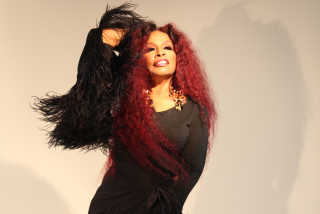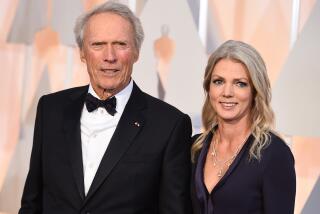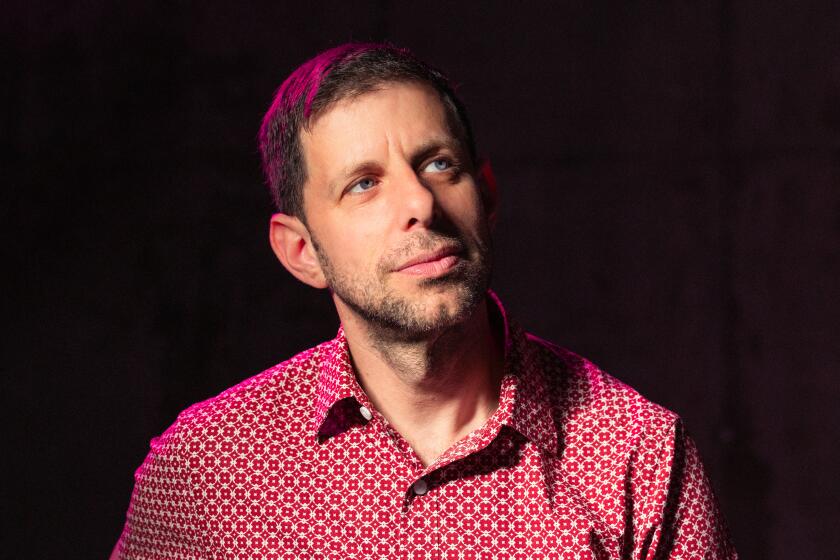Art and the L.A. River
One of Chaz Bojórquez’s fondest childhood memories is of climbing down into the L.A. River basin around Highland Park, running and sliding in 2 inches of water enclosed in a moss-covered tunnel — his “Tom Sawyer swimming pool,” as he called it.
For many Angelenos the L.A. River is just another concrete surface viewed from their car windows. A waterless paved gorge filled with graffiti, grit and vagrants but also a sentimental symbol of the city’s cinematic history that provided a convenient location for movies such as “Terminator 2,” “Grease” and “Transformers.”
For Bojórquez and other L.A. artists, it was a place for childhood adventures, an escape from the city and inspiration for creating art. A collection of work inspired by the waterway has been captured at “The Ulysses Guide to the Los Angeles River” at the Pasadena Museum of California Art through July 4.
Reflective of Los Angeles, the exhibition is a vibrant, cross section of more than 25 pieces of watercolors, charcoal drawings, sculpture, Masonite elements, draft designs, acrylics, spray paint, photography and even an “oil on cockroach.”
The art includes a peacock sketch by tattoo artist Jack Rudy, Dennis Kunkel’s microscopic images of a pill bug and Evan Skrederstu’s oil painting “River Tropical,” an island fantasy of a hammocked hippie relaxing along the shore.
Bojórquez, considered one of L.A.’s first graffiti artists and the oldest in show at 61, briefly attended Chouinard Art Institute (now known as CalArts). His work has been featured at the Smithsonian and LACMA. “I found my cultural identity in the river,” said Bojórquez, who first discovered its beauty and nature walking in the middle of the night to hide from the police. “The broken bottles sparkling in the light of the moon and the sound of the water and speeding cars was very romantic,” Bojórquez recalled.
In the early 20th century, floods wreaked havoc on the city, so in 1938 the Army Corps of Engineers began paving over the river. Detractors believed the transformation created a different kind of havoc as a playground for gangs, delinquents and the homeless.
For research, Steve Martinez and fellow artists and curators Skrederstu and Christopher D. Brand hiked the 51 miles of the river bed, which stretches from Canoga Park through downtown and ends in Long Beach. Except for a few run-ins with seedy survivalists and coyotes, they encountered exotic fauna, insects, reptiles and egrets.
The endless white space provided a huge canvas for anyone enticed to venture into the depths and express their creativity. “There were some beautiful murals down there from 15 to 20 years ago we were able to capture before they painted them over,” said Martinez, referring to a project by the city to rid the river walls and embankments of gang tags.
The exhibition, based on a book of the same name, re-creates the experience of being in the river with trash, plants, exposed concrete, birds’ nests and green muck integrated along the gallery floor, ceiling and corners with a piped-in soundscape of running water, traffic and birds.
“Survivors of the Massacre” is an acrylic painting by Martinez and Skrederstu of a teddy bear and plastic elephant found at the bottom of the river. Bags of worn-out stuffed animals had been tossed over a wall resulting in a calamitous explosion of stuffing and fur. Also discovered on the trek were hobo etchings that dated as far back as 1914. Said Martinez, “It’s a natural thing for a person to say ‘I existed in this world’ and leave their mark.”
More to Read
The biggest entertainment stories
Get our big stories about Hollywood, film, television, music, arts, culture and more right in your inbox as soon as they publish.
You may occasionally receive promotional content from the Los Angeles Times.






